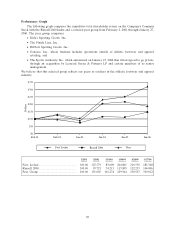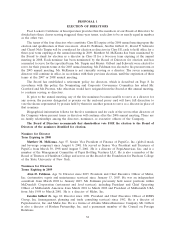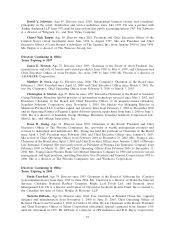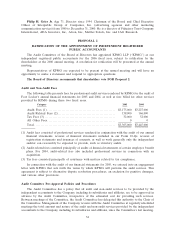Foot Locker 2005 Annual Report Download - page 128
Download and view the complete annual report
Please find page 128 of the 2005 Foot Locker annual report below. You can navigate through the pages in the report by either clicking on the pages listed below, or by using the keyword search tool below to find specific information within the annual report.PROPOSAL 3
REAPPROVAL OF THE PERFORMANCE GOALS OF THE
LONG-TERM INCENTIVE COMPENSATION PLAN
Under Section 162(m) of the Internal Revenue Code, the Company cannot deduct certain
compensation in excess of $1 million paid to the named executive officers of the Company (each, a
“Covered Employee’’). Certain compensation, including compensation paid based on the achievement
of pre-established performance goals, is excluded from this deduction limit if the material terms under
which the compensation is to be paid, including the performance goals to be used, are approved by
shareholders. Shareholders approved the Long-Term Plan, amended and restated as of January 28,
1996, at the 1996 annual meeting, which satisfied these requirements. Shareholders reapproved the
performance goals for this plan at the 2001 annual meeting. Section 162(m) requires that shareholders
reapprove the performance goals under the plan every five years.
Material Features of the Long-Term Plan
The following is a summary of the principal features of the Long-Term Plan and is qualified in its
entirety by the complete text of the Long-Term Plan. Capitalized terms used but not defined in this
summary have the meanings contained in the Long-Term Plan.
Section 409A of the Internal Revenue Code, which was enacted as part of the American Jobs
Creation Act of 2004, deals with specific tax rules for nonqualified deferred compensation plans. The
Company intends to amend certain provisions of the Long-Term Plan prior to the expiration of the
transition period on December 31, 2006 in order to bring the plan into documentary compliance with
this section of the Internal Revenue Code and related regulations; however, these amendments will in
no way change the performance goals under the plan approved by shareholders.
Purpose of the Plan. The purposes of the Long-Term Plan are to reinforce corporate,
organizational, and business development goals; to promote the achievement of year-to-year financial
and other business objectives; to reward the performance of individual officers and other employees in
fulfilling their personal responsibilities for year-to-year achievements; and to serve as a qualified
performance-based compensation program under Section 162(m) of the Internal Revenue Code with
regard to Covered Employees.
Administration. Currently, the Long-Term Plan is administered by the Compensation and
Management Resources Committee, each member of which is an “outside director’’ under Section
162(m) of the Internal Revenue Code. The Long-Term Plan also provides that the plan may be
administered by a sub-committee of the Compensation and Management Resources Committee. The
Committee has the authority to grant awards, determine performance criteria, certify attainment of
performance goals, construe and interpret the Long-Term Plan and make all other determinations
deemed necessary or advisable for the administration of the Long-Term Plan.
Participation. Participation in the Long-Term Plan is limited to those officers and other key
employees of the Company, its subsidiaries and divisions, as selected by the Committee. In determining
the persons to whom awards shall be granted, the Committee takes into account such factors as the
Committee deems appropriate to accomplish the purposes of the Long-Term Plan. Currently, 23
executives participate in this plan.
Performance Periods and Individual Target Awards. Long-Term Plan awards relate to a period of
three consecutive plan years or such other period as determined by the Committee, beginning with the
Plan Year in which the award is made (the “Performance Period). The individual target award for each
participant is expressed as a percentage of Annual Base Salary.
Payment. In general, payment for such awards shall be made only if and to the extent performance
goals for the Performance Period are attained and only if the participant remains employed by the
Company throughout the Performance Period. Payment to a participant for each Performance Period
will be made in cash or shares of Common Stock. If payment is made in shares of stock, the number of
shares of Common Stock is determined by dividing the achieved percentage of a participant’s Annual
Base Salary by the Fair Market Value of the Common Stock on the date of payment. “Fair Market
36



















